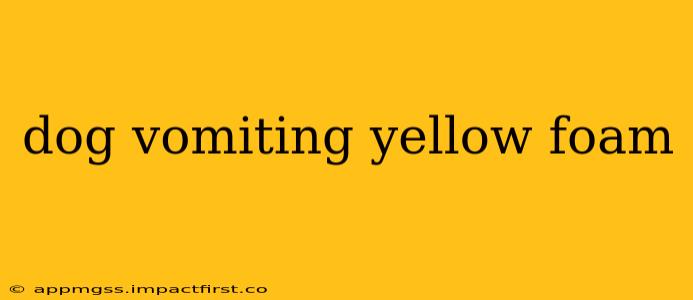Seeing your dog vomit yellow foam can be alarming. It's a symptom that warrants attention, as it can indicate various underlying health issues, ranging from mild indigestion to serious medical conditions. This comprehensive guide will explore the potential causes of yellow foam vomiting in dogs, how to treat it, and when you should seek immediate veterinary care.
What Causes Yellow Foam Vomiting in Dogs?
Yellow foam vomit in dogs often results from bile. Bile is a digestive fluid produced by the liver and stored in the gallbladder. When the stomach is empty, bile can accumulate and be regurgitated, leading to the characteristic yellow, foamy appearance. Several factors can contribute to this:
-
Empty Stomach: This is the most common and often least serious cause. Dogs who haven't eaten for an extended period may vomit bile due to the accumulation of this digestive fluid. This is especially common in the mornings before feeding.
-
Gastritis: Inflammation of the stomach lining (gastritis) can cause vomiting, often including yellow foam. Gastritis can be triggered by various factors, including dietary indiscretions, stress, infections, or ingestion of toxins.
-
Pancreatitis: Inflammation of the pancreas, a critical organ in digestion, is a more serious condition that can cause vomiting, including yellow foam, along with other symptoms such as lethargy, abdominal pain, and diarrhea.
-
Liver Disease: Problems with the liver, such as liver failure or hepatitis, can affect bile production and lead to yellow foam vomiting. Other signs of liver disease may include jaundice (yellowing of the skin and whites of the eyes), weight loss, and changes in appetite.
-
Intestinal Obstructions: Blockages in the intestines can prevent the normal flow of food and bile, potentially causing vomiting of yellow foam. This can be a life-threatening situation.
-
Infections: Viral or bacterial infections can cause vomiting, including yellow foam, alongside other symptoms like fever, lethargy, and loss of appetite.
-
Kidney Disease: In some cases, kidney disease can contribute to vomiting, though this is less directly linked to yellow foam than other issues.
How to Treat Dog Vomiting Yellow Foam
Treatment depends entirely on the underlying cause. Do not attempt to treat your dog without consulting a veterinarian. They can diagnose the issue through a physical exam, blood tests, urine tests, and possibly imaging techniques such as X-rays or ultrasound. Treatment might include:
-
Dietary Changes: For mild cases, like those caused by an empty stomach, simple adjustments to feeding schedules may be sufficient. Smaller, more frequent meals can help prevent bile buildup.
-
Medication: Depending on the diagnosis, your vet might prescribe medication to address gastritis, infections, or other underlying conditions. This could include anti-emetics to reduce vomiting, antibiotics for infections, or medications to manage other diseases.
-
Fluid Therapy: Dehydration is a significant concern with vomiting, so intravenous (IV) fluids may be necessary to rehydrate your dog.
-
Surgery: In cases of intestinal obstructions or other surgical emergencies, surgery might be required.
When to See a Vet Immediately
Seek immediate veterinary attention if your dog is exhibiting any of the following, in addition to vomiting yellow foam:
-
Lethargy or weakness: A significant decrease in energy levels is a cause for concern.
-
Loss of appetite: Refusal to eat can indicate a more serious underlying problem.
-
Bloody vomit: Blood in the vomit indicates internal bleeding and requires urgent veterinary care.
-
Severe abdominal pain: Signs of abdominal pain, such as whimpering or guarding their abdomen, require immediate attention.
-
Dehydration: Signs of dehydration, including sunken eyes, dry gums, and lethargy, indicate a need for immediate veterinary intervention.
-
Diarrhea: Vomiting combined with diarrhea can lead to rapid dehydration.
-
Fever: An elevated body temperature suggests a possible infection.
What are Other Symptoms Associated with Dog Vomiting Yellow Foam?
This is a frequently asked question. Beyond the obvious yellow foam vomit, other symptoms might include:
- Loss of appetite: Your dog may refuse food or show a decreased interest in eating.
- Lethargy: Your dog may seem less energetic than usual, sleeping more than normal.
- Abdominal pain: They might whimper or show signs of discomfort when their abdomen is touched.
- Diarrhea: This often accompanies vomiting, exacerbating dehydration.
- Dehydration: Look for signs like dry gums, sunken eyes, and lethargy.
Is Vomiting Yellow Foam in Dogs Always Serious?
While sometimes simply a result of an empty stomach, yellow foam vomiting can also be a sign of a significant health problem. The severity depends on the underlying cause, and it's crucial to consult a veterinarian for accurate diagnosis and treatment. Never assume it's a minor issue.
Can I Give My Dog Home Remedies for Yellow Foam Vomiting?
It is best to avoid home remedies, and to instead contact your vet. While some suggest remedies, these can sometimes interfere with a vet's diagnosis and treatment plan.
This information is for educational purposes only and should not replace professional veterinary advice. If your dog is vomiting yellow foam, it's vital to consult your veterinarian for a proper diagnosis and treatment plan. Early intervention can significantly improve your dog's chances of a full recovery.
